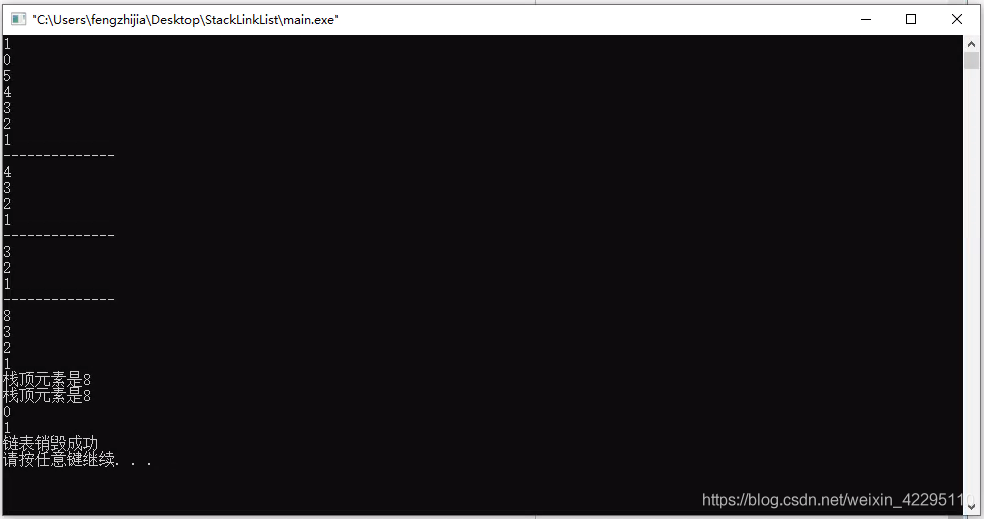栈的链表实现也有两种,一种是带头结点的链表的实现方式,一种是不带头结点的链表的实现方式。
第一种:(带头结点的栈的实现方式)
基础代码:
#include<stdio.h>
#include<stdlib.h>
#define null NULL
#define ElemType int
typedef struct LinkStack {
ElemType data;
struct LinkStack *next;
}LinkStack;
栈的初始化:
//初始化
bool initStack(LinkStack **head){
*head = (LinkStack *)malloc(sizeof(LinkStack));
if(*head == null){
return false;
}
(*head)->next = null;
return true;
}
判空:
//判空
bool isEmpty(LinkStack *head){
return head->next == null;
}
入栈:
//入栈 Push
bool Push(LinkStack *head,ElemType e){
LinkStack *s = (LinkStack *)malloc(sizeof(LinkStack));
s->data = e;
s->next=head->next;
head->next=s;
return true;
}
出栈:
//出栈 Pop
bool Pop(LinkStack *head,ElemType &x){
//判栈空
if(head->next == null){
return false;
}
LinkStack *q=head->next;
x =q->data;
head->next=q->next;
free(q);
return true;
}
获取栈顶元素:
//获取栈顶元素
bool GetTopElem(LinkStack *head,ElemType &x){
//判空
if(head->next == null){
return false;
}
x=head->next->data;
return true;
}
栈的删除:
//栈的删除(保留头结点)
bool DeleteStack(LinkStack *head){
while(head->next!=null){
LinkStack *q = head->next;
head->next = q->next;
free(q);
}
}
栈的销毁:
//栈的销毁(连头结点一起删除)
bool DestoryStack(LinkStack **head){
while((*head)->next != null){
LinkStack *q = (*head)->next;
(*head)->next = q->next;
free(q);
}
free(*head);
*head=null; //将main函数中的head指针置为null,避免其成为野指针。
}
栈的打印操作:
//栈的打印操作
void printStack(LinkStack *head){
while(head->next!=null){
ElemType data = head->next->data;
printf("%d\n",data);
head=head->next;
}
}
?测试代码及结果:
int main(int argc, char *argv[])
{
LinkStack *head = null;
//初始化栈
initStack(&head);
//判断栈空
bool flag = isEmpty(head);
printf("%d\n",flag);
//打印栈
printStack(head);
//入栈
Push(head,1);
Push(head,2);
Push(head,3);
Push(head,4);
Push(head,5);
//判断栈空
bool flag1 = isEmpty(head);
printf("%d\n",flag1);
//打印栈
printStack(head);
//出栈
ElemType e;
Pop(head,e);
//打印栈
printf("--------------\n");
printStack(head);
Pop(head,e);
printf("--------------\n");
printStack(head);
Push(head,8);
printf("--------------\n");
printStack(head);
GetTopElem(head,e);
printf("栈顶元素是%d\n",e);
GetTopElem(head,e);
printf("栈顶元素是%d\n",e);
//判断栈空
bool flag2 = isEmpty(head);
printf("%d\n",flag2);
//清空栈
DeleteStack(head);
//判断栈空
bool flag3 = isEmpty(head);
printf("%d\n",flag3);
//销毁链表
DestoryStack(&head);
if(head == null){
printf("链表销毁成功\n");
}
return 0;
}

第二种(不带头结点的栈的实现方式):
栈的初始化:
//初始化
bool initStack(LinkStack **head){
*head = null;
return true;
}
判空:
//判空
bool isEmpty(LinkStack *head){
return head==null;
}
入栈:(使用二级指针)
//入栈 Push //得使用二级指针 //如果使用一级指针,会导致我们每次入栈的时候会在堆内存中创建一个结点,而这个结点随着Push函数调用结束,而长久驻留在堆内存中,这种方式会导致内存泄漏,而main函数中的head指针依然指向的null
bool Push(LinkStack **head,ElemType e){
LinkStack *s = (LinkStack *)malloc(sizeof(LinkStack));
s->data = e;
//入栈的第一个元素
if(*head == null){
s->next = null;
*head=s;
}else{
//入栈非第一个元素
s->next = *head;
*head=s;
}
return true;
}
出栈:(使用二级指针)
//出栈 Pop //得用二级指针 //使用一级指针会导致我们释放了q结点之后,main函数中的head指针依然指向q这块未知内存,导致head指针指向了未知位置,成为了野指针,程序不再受控。
bool Pop(LinkStack **head,ElemType &x){
//判栈空
if(*head == null){
return false;
}
LinkStack *q=*head;
x =q->data;
*head=q->next;
free(q);
return true;
}
获取栈顶元素:
//获取栈顶元素
bool GetTopElem(LinkStack *head,ElemType &x){
//判空
if(head == null){
return false;
}
x=head->data;
return true;
}
栈的销毁:
//栈的销毁
bool DestoryStack(LinkStack **head){
while(*head != null){
LinkStack *q = *head;
*head = q->next;
free(q);
}
}
栈的打印:
//栈的打印操作
void printStack(LinkStack *head){
while(head != null){
ElemType data = head->data;
printf("%d\n",data);
head=head->next;
}
}
测试代码及结果:
int main(int argc, char *argv[])
{
LinkStack *head;
//初始化栈
initStack(&head);
//判断栈空
bool flag1 = isEmpty(head);
printf("%d\n",flag1);
//入栈
Push(&head,1);
Push(&head,2);
Push(&head,3);
Push(&head,4);
Push(&head,5);
//判断栈空
bool flag2 = isEmpty(head);
printf("%d\n",flag2);
//打印栈
printf("------------------\n");
printStack(head);
//出栈
ElemType e;
Pop(&head,e);
//打印栈
printf("--------------\n");
printStack(head);
Pop(&head,e);
printf("--------------\n");
printStack(head);
Push(&head,8);
printf("--------------\n");
printStack(head);
//获取栈顶元素
GetTopElem(head,e);
printf("栈顶元素是%d\n",e);
GetTopElem(head,e);
printf("栈顶元素是%d\n",e);
//判断栈空
bool flag3 = isEmpty(head);
printf("%d\n",flag3);
//销毁栈
DestoryStack(&head);
//判断栈空
bool flag4 = isEmpty(head);
printf("%d\n",flag4);
if(head == null){
printf("栈销毁成功\n");
}
return 0;
}

总结: 栈的链表实现方式中,带头结点的实现方式比不带头结点的实现方式简单、方便。(即第一种方式优于第二种方式)
| 
